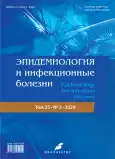Сравнительная оценка частоты и факторов риска гнойно-септических инфекций у взрослых после различных видов операций на открытом и закрытом сердце
- Авторы: Сергевнин В.И.1, Кудрявцева Л.Г.2
-
Учреждения:
- ФГБОУ ВО «Пермский государственный медицинский университет имени академика Е.А. Вагнера» Минздрава России
- ФГБУ «Федеральный центр сердечно-сосудистой хирургии имени С.Г. Суханова» Минздрава России
- Выпуск: Том 25, № 2 (2020)
- Страницы: 78-87
- Раздел: ОРИГИНАЛЬНЫЕ ИССЛЕДОВАНИЯ
- URL: https://journals.rcsi.science/1560-9529/article/view/34993
- DOI: https://doi.org/10.17816/EID34993
- ID: 34993
Цитировать
Полный текст
Аннотация
Обоснование. Повсеместный рост числа и видов кардиохирургических вмешательств требует изучения частоты и факторов риска послеоперационных гнойно-септических инфекций (ГСИ).
Цель исследования ― дать сравнительную оценку частоты и факторов риска ГСИ у взрослых после различных видов кардиохирургических операций.
Материалы и методы. По материалам кардиохирургического стационара проведено изучение медицинских карт 4815 пациентов в возрасте старше 18 лет, прооперированных в течение года на открытом (n = 1540) и закрытом (n = 3275) сердце. Учитывали типичные и донозологические формы ГСИ в соответствии с эпидемиологическим стандартным определением случаев.
Результаты. После кардиохирургических операций на открытом сердце показатель заболеваемости типичными ГСИ составил 39,6, донозологическими формами ― 72,7 на 1000 операций, после малоинвазивных эндоваскулярных операций ― 3,1 и 3,9 соответственно. Основными клиническими формами ГСИ после операций на открытом и закрытом сердце были инфекция в области хирургического вмешательства, внутрибольничная пневмония, инфекция мочевыводящих путей, инфекция кровотока. При операциях на открытом сердце максимальные показатели заболеваемости типичными и донозологическими формами ГСИ регистрировались после операций на аорте, реже ― после протезирования клапанов сердца и аортокоронарного шунтирования. Повышенный уровень заболеваемости после операций на аорте был обусловлен преимущественно инфекцией мочевыводящих путей и внутрибольничной пневмонией. При операциях на закрытом сердце статистически значимых различий между показателями заболеваемости ГСИ после стентирования коронарных артерий, операций по поводу нарушений ритма сердца, стеноза сонной артерии и прочих вмешательств не выявлено. Установлено, что в качестве факторов риска ГСИ после кардиохирургических операций существенное значение имеет длительность как самой операции, так и последующего пребывания пациентов в отделении реанимации.
Заключение. Уровень заболеваемости ГСИ после операций на открытом сердце значительно выше, чем после операций на закрытом сердце, что в значительной степени связано с длительностью оперативного вмешательства и последующего пребывания пациентов в отделении реанимации.
Полный текст
Открыть статью на сайте журналаОб авторах
Виктор Иванович Сергевнин
ФГБОУ ВО «Пермский государственный медицинский университет имени академика Е.А. Вагнера» Минздрава России
Email: viktor-sergevnin@mail.ru
ORCID iD: 0000-0002-2729-2248
доктор медицинских наук, профессор кафедры эпидемиологии и гигиены
Россия, 614990 город Пермь, улица Петропавловская, 26Лариса Геннадьевна Кудрявцева
ФГБУ «Федеральный центр сердечно-сосудистой хирургии имени С.Г. Суханова» Минздрава России
Автор, ответственный за переписку.
Email: Kudryavcevalg@mail.ru
ORCID iD: 0000-0002-2707-0768
кандидат медицинских наук, заведующий эпидемиологическим отделом – врач-эпидемиолог
Россия, 614013; г. Пермь, ул. Маршала Жукова,35Список литературы
- Бокерия Л.А., Гудкова Р.Г. Сердечно-сосудистая хирургия-2011. Болезни и врожденные аномалии системы кровообращения. – М.: НЦССХ им. А.Н. Бакулева РАМН, 2012. – 196 с.
- Алекян Б.Г., Григорьян А.М., Стаферов А.В., Карапетян Н.Г. Рентгеноваскулярная диагностика и лечение заболеваний сердца и сосудов в Российской Федерации – 2017 год // Эндоваскулярная хирургия. – 2018. – Т.5. – №2. – С. 93–240. doi: 10.24183/2409-4080-2018-5-2-93-240.
- Бахронов Ш.Р. Развитие эндоваскулярных методов лечения серьезных заболеваний сердечно-сосудистой системы человека и анализ возможных осложнений // Авиценна. – 2018. – №21. – С. 32−41.
- Арефьева Л.И., Горская Е.М., Савостьянова О.А., и др. Инфекционные осложнения бактериальной природы в сердечно-сосудистой хирургии // Российский медицинский журнал. – 2013. – №3. – С. 36−42.
- Казачек Я.В., Помешкина С.А., Барбараш О.А. Профилактика инфекционных осложнений в кардиохирургии // Комплексные проблемы сердечно-сосудистых заболеваний. – 2014. – №4. – С. 62−69. doi: 10.17802/2306-1278-2014-4-62-69.
- Попов Д.А. Послеоперационные инфекционные осложнения в кардиохирургии // Анналы хирургии. – 2013. – №5. – С. 15−21.
- Настас А.Ф. Эпидемиология внутрибольничных гнойно-септических инфекций у послеоперационных кардиохирургических пациентов // Научные горизонты. – 2018. – №2. – С. 201−217.
- O’Keefe S., Williams K., Legare J.F. Hospital-acquired infections after cardiac surgery and current physician practices: a retrospective cohort study. J Clin Med Res. 2017;9(1):10-16. doi: 10.14740/jocmr2637w.
- Габриэлян Н.И. Гнойно-септические осложнения в трансплантологии и кардиохирургии: эпидемиология и профилактика: Автореф. дис. … докт. мед. наук. – М., 2011. – 47 с. Доступно по: https://search.rsl.ru/ru/record/01004852215. Ссылка активна на 15.03.2020.
- Сажин А.В., Тягунов А.Е., Нечай Т.В., и др. Диагностика и лечение гнойных осложнений в зоне имплантированного электрокардиостимулятора // Российский медицинский журнал. – 2013. – №1. – С. 41−45.
- Johansen J.B., Jorgensen O.D., Møller M., et al. Infection after pacemaker implantation: infection rates and risk factors associated with infection in a population-based cohort study of 46299 consecutive patients. Eur Heart J. 2011;32(8):991-998. doi: 10.1093/eurheartj/ehq497.
- Kusumoto F.M., Schoenfeld M.H., Wilkoff B.L., et al. 2017 HRS expert consensus statement on cardiovascular implantable electronic device lead management and extraction. Heart Rhythm. 2017;14(12):e503-551. doi: 10.1016/j.hrthm.2017.09.001.
- Lekkerkerker J.C., van Nieuwkoop C., Trines S.A., et al. Risk factors and time delay associated with cardiac device infections: Leiden device registry. Heart. 2009;95(9):715-720. doi: 10.1136/hrt. 2008.151985.
- European Centre for Disease Prevention and Control. Point prevalence survey of health care associated infections and antimicrobial use in European acute care hospitals – protocol version 4.3. Stockholm: ECDC; 2012. https://www.ecdc.europa.eu/en/publications-data/point-prevalence-survey-healthcare-associated-infections-and-antimicrobial-use
- Сергевнин В.И., Ключарева Н.М. Предэпидемическая диагностика заболеваемости внутрибольничными гнойно-септическими инфекциями // Здоровье населения и среда обитания. – 2018. – №1. – С. 27−29. doi: 10.35627/2219-5238/2018-298-1-27-29.
- Руднов В.А., Зубарев А.С. Инфекции в отделении реанимации и интенсивной терапии, вызванные P. aeruginosa и Acinetobacter spp. // Consilium Medicum. – 2008. – Т.10. – №1. – С. 37−44.
- Сергевнин В.И., Ключарева Н.М. Проявления эпидемического процесса гнойно-септических инфекций среди пациентов реанимационного отделения многопрофильной больницы и антибиотикочувствительность возбудителей // Эпидемиология и вакцинопрофилактика. – 2013. – №1. – С. 23−29.
Дополнительные файлы






